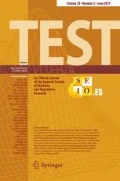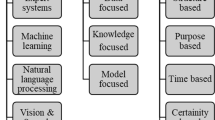Abstract
In manufacturing science, process capability indices play a role analogous to economic indices in government statistics. The existing capability indices are passive devices whose main role is to retroactively monitor process capability. The have been developed under the restrictive assumption of process stability, and the procedures for using them are based on ad hoc rules. Using the normative point of view for decision making, it can be shown that some of the indices are, at best, convoluted special cases of a more general strategy; they can be justified only under special assumptions, and the manner in which they are currently used could lead to incoherent actions. The available process capability indices should therefore be abandoned and replaced by procedures that are normative, and also proactive with respect to both, prediction and control. An approach towards achieving this goal is proposed.
Similar content being viewed by others
References
Bernardo, J.M. and T.Z. Irony (1996). A general multivariate Bayesian process capability index.The Statistician,45, 3, 487–502.
Bernardo, J. M. and A. F. M. Smith (1994).Bayesian theory. John Wiley, Chichester.
Billingsley, P. (1986).Probability and measure. John Wiley and Sons, Inc.
Bissell, A. F. (1990). How reliable is your capability index?.Applied Statistics,39, 331–340.
Box, G.E.P. and G. M. Jenkins (1976).Time series analysis, forecasting and control. Holden-Day, San Francisco.
Chan, L. K., S. W. Cheng and F. A. Spiring (1988a). A new measure of process capability:C pm .Journal of Quality Technology,20, 162–175.
Chen, H. (1994). A multivariate process capability index over a rectangular solid tolerance zone.Statistica Sinica,4, 749–758.
Cheng, S. W. and F. A. Spiring (1989). Assessing process capability: a Bayesian approach.IIE Transactions,21, 97–98.
Fries, A. and K. J. Richter (1993) (Appendix E). Process capability and performance indices. Defence Science Board Task Force Report, Engineering in the Manufacturing Process.
Grant, E. L. and R. S. Leavenworth (1974).Statistical quality control, 5th Edition. McGraw Hill, New York, NY.
Gupta, A. K. and S. Kotz (1997). A new process capability index.Metrika,45, 213–224.
Harry, M. J. and J. R. Lawson (1992).Six sigma producibility analysis and process characterization. Addison-Wesley Publishing Co. Inc.
Hsiang, T. C. and G. Taguchi (1985). A tutorial on quality control and assurance—The Taguchi method.ASA Annual Meeting, Las Vegas.
Juran, J. M. (1974).Jurans quality control handbook, 3rd edition. McGraw-Hill, New York.
Juran, J. M. and F. Gryna (1980).Quality planning and analysis. McGraw-Hill, New York.
Kane, V. E. (1986). Process capability indices.Journal of Quality Technology,18, 41–52.
Kotz, S. and C. R. Lovelace (1997).Process capability indices in theory and practice. Arnold, London. To be published.
Kushler, R. H. and P. Hurley (1992). Confidence bounds for capability indices.Journal of Quality Technology,24, 4, 188–195.
Meinhold, R. J. and N. D. Singpurwalla (1983). Understanding the Kalman filter.The American Statistician,37, 2, 123–127.
Meinhold, R. J. and N. D. Singpurwalla (1989). Robustification of Kalman filter models.Journal of the American Statistical Association,84, 406, 479–488
Pearn, W. L., S. Kotz and N. L. Johnson (1992). Distributional and inferential properties of process capability indices.Journal of Quality Technology,24, 216–231. (Abbreviated as PKJ).
Pearn, W. L. and K. S. Chen (1996). A Bayesian-like estimator ofC pk .Communications in Statistics.
Singpurwalla, N.D. (1992). A Bayesian perspective on Taguchi's approach to quality engineering and tolerance design (with discussion).IIE Transactions,24, 5, 18–32.
Spiring, F. A. (1991). Assessing process capability in the presence of systematic assignable cause.Journal of Quality Technology,23, 2, 125–134.
Taam, W., P. Subbaiah and J. W. Liddy (1993). A note on multivariate capability indices.Journal of Applied Statistics,20, 339–351.
Vännman, K. (1995). A Unified approach to capability indices.Statistica Sinica,5, 2, 805–822.
Vännman, K. (1996a). Capability indices when tolerances are asymmetric. Paper to be presented at the Cochin-ISI/QISM Conference, Cochin, India.
Vännman, K. (1996b). Families of capability indices for one-sided specification limits. Paper to be presented at the Cochin-ISI/QISM Conference, Cochin, India.
Wierda, S. J. (1993). A multivariate process capability index.Transactions, ASQC Quality Congress, 342–348.
Wright, P. A. (1995). A process capability index sensitive to skewness.Journal of Statistical Computation and Simulation,52, 195–203.
References
Aström, K.J., and B. Wittenmark (1984).Computer Controlled Systems: Theory and Design. Prentice Hall, Englewood Cliffs, NJ.
Box, G.E.P. and G.M. Jenkins (1968). Discrete Models for Feedback and Feed-Forward Control.The Future of Statistics (D.G. Watts ed.). Academic Press, New York, pp. 201–240.
Box, G.E.P., and G.M. Jenkins (1970).Time Series Analysis, Forecasting and Control. Holden-Day, San Francisco.
Box, G.E.P., G.M. Jenkins and G.C. Reinsel (1994).Time Series Analysis, Forecasting and Control, 3rd ed. Prentice Hall, Englewood Cliffs, NJ.
Box, G.E.P. and T. Kramer (1992). Statistical process monitoring and feedback adjustment. A discussion.Technometrics,34, 251–285.
Box, G.E.P. and A. Luceño (1994). Selection of sampling interval and action limits for discrete feedback adjustment.Technometrics,36, 369–378.
Box, G.E.P. and A. Luceño (1995). Discrete proportional-integral control with constrained adjustment.Journal of the Royal Statistical Society, Series D—The Statistician,44, 479–495.
Box, G.E.P. and A. Luceño (1997). The anatomy and robustness of discrete proportional-integral adjustment and its application to statistical process control.Journal of Quality Technology,29, 248–260.
Box, G.E.P. and A. Luceño (1997).Statistical Control by Monitoring and Feedback Adjustment. J. Wiley, NY.
MacGregor, J.F. (1972).Topics in the Control of Linear Processes Subject to Stochastic Disturbances. Unpublished Ph.D. thesis, University of Wisconsin-Madison.
Whittle, P. (1963).Prediction and Regulation by Linear Least-Squares Methods. English University Press, London.
References
Cox, D.R. (1990). Quality and reliability: some recent developments and a historical perspective.Journal of the Operational Research Society,41, 95–101.
References
Azzalini, A. & Dalla Valle, A. (1996). The multivariate skew-normal distribution.Biometrika,83, 715–726.
Chen, H. (1994). A multivariate process capability index over rectangular solid tolerance zone.Statistica Sinica,4, 749–758.
Chen, M-H. & Dey, D.K. (1998). Bayesian modeling of correlated binary response via scale mixture of multivariate normal link functions.Sankhya, Series A, to appear.
Geisser, S. (1993).Predictive Inference: An Introduction. London: Chapman and Hall.
Niverthi, M. (199). Bayesian methods for quality control and software reliability.Ph.D. thesis, Department of Statistics, University of Connecticut.
Gelfand, A. & Smith, A. (1990). Sampling babased approaches to calculating marginal densities.Journal of the American Statistical Association,85, 398–409.
References
A.N. Shirayev (1978).Optimal stopping Rules, Springer, New York.
References
Meinhold, R.J. and N.D. Singpurwalla (1983). Understanding the Kalman filter.The American Statistician,37, 2, 123–127.
Meinhold, R.J. and N.D. Singpurwalla (1989). Robustification of Kalman filter models.Journal of the American Statistical Association,84, 479–486.
Gómez, E., M.A. Gómez-Villegas and J.M. Marín (1998). A multivariate generalization of the power exponential family of distributions.Communications in Statistics (Theory and Methods),27, 3, 589–601.
References
Deming, W. E. (1982).Quality, Productivity and Competitve Position, M.I.T. Center for Advanced Engineering Study, Cambridge, MA.
Deming, W. E. (1988).Out of the Crisis. M.I.T. Center for Advanced Engineering Study. Cambridge, MA.
Grubbs, F. S. (1983). An optimal procedure for setting machines.Journal of Quality Technology,5, 4, 155–208.
References
Bernardo, J.M. and T.Z. Irony (1996). A general multivariate Bayesian process capability index.The Statistician,45, 3, 487–502
References
Berti, P. and R. Rigo (1998). Coherence-an Update. To appear in theEncyclopedia of Statistical Sciences,Vol. 3 (Update), J. Wiley, NY.
Gillipsie C.C. (1997).Pierre-Simon Laplace. A Life in Exact Science, Princeton University Press, Princeton, NJ, pp. 272–273.
Kotz, S. and N.L. Johnson (1993).Process Capability Indices. Chapman and Hall, London.
Kotz, S. and C.R. Lovelace (1998).An Introduction to Process Capability Indices. Arnold, London. (forthcoming)
References
West, M. & Harrison, J. (1989).Bayesian Forecasting and Dinamyc Models. New York: Springer-Verlag.
References
Bisell, D. (1994).Statistical Methods for SPC and TQM. Chapman and Hall.
Box, G.E.P. and A. Luceño (1997)Statistical Control by Monitoring and Feedback Adjustment. J. Wiley.
Cox, D. R. (1960). Serial Sampling Acceptance Schemes Derived from Bayes Theorem.Technometrics,2, 3, 353–360.
Hamburg M. (1962). Bayesian Decision Theory and Statistical Quality Control.Industrial Quality Control,19, 6, 10–14.
Montgomery, D. C. and C. M. Mastrangelo (1991). Some Statistical Process Control Methods for Dependent Data.Journal of Quality Technology,23, 3, 179–203.
Roberts, S.W. (1959). Control Charts based on Geometric Moving Averages.Technometrics,1, 239–250.
References
Conlin, M. (1998). Revealed at last: the secret of Jack Welch's success.Forbes, January 26, 1998, p. 44.
Lindley, D. V. and N. D. Singpurwalla (1991). On the evidence needed to reach agreed action between adversaries with application to acceptance sampling.Journal of the American Statistical Association,86, 416, 933–937.
Lindley, D. V. and N. D. Singpurwalla (1993). Adversarial life testing.Journal of the Royal Statistical Society, Series B,55, 4, 837–847.
Author information
Authors and Affiliations
Additional information
Research Sponsored by The National Institute of Standards and Technology Gaithersburg, Maryland 20899-0001 (Under Purchase Order No. 43NANB610868), The U.S. Army Research Office Grant DAAG-55-97-1-0323, and The Air Force Office of Scientific Research Grant AFOSR-F-49620-95-0107
Rights and permissions
About this article
Cite this article
Singpurwalla, N.D., Box, G., Cox, D.R. et al. The stochastic control of process capability indices. Test 7, 1–74 (1998). https://doi.org/10.1007/BF02565102
Issue Date:
DOI: https://doi.org/10.1007/BF02565102




